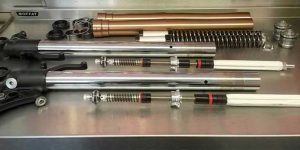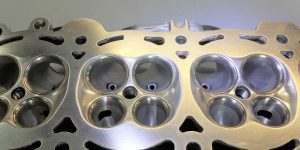BSB Weekend write up
For this blog I am going to give an insight into a typical race weekend at BSB, working as a mechanic/crew chief for a British Supersport team. Without going into too much detail or giving away any secrets I’ll explain what is involved in running a bike at this level of motorcycle racing.
 The lorry turns up at the circuit Wednesday afternoon and parks behind the allocated garage before the paddock fills up with other competitors and traders the following day. The garage is built up during Thursday with the flooring, wall panels, lighting, power cables and tool boxes etc., and the part time team members (including myself) turn up on the Thursday evening. With my role I am in charge of one of the bikes, so on Thursday evening I will go over the bike and check everything is OK and that everything is ready for Friday morning.
The lorry turns up at the circuit Wednesday afternoon and parks behind the allocated garage before the paddock fills up with other competitors and traders the following day. The garage is built up during Thursday with the flooring, wall panels, lighting, power cables and tool boxes etc., and the part time team members (including myself) turn up on the Thursday evening. With my role I am in charge of one of the bikes, so on Thursday evening I will go over the bike and check everything is OK and that everything is ready for Friday morning.
Friday is practice day with 1 morning session and 1 afternoon session, with the morning one starting around 10am for the Supersport class. The bike preparation starts 2 hours before the session begins. This consists of putting the tyre warmers on 2 sets of tyres (1 set in the bike and 1 spare set), fuelling the bikes and putting the settings in the bike most suited to the track and weather conditions. To decide what settings to put in the bike I will sit down with the rider and go through data and settings from previous visits to the circuit, look at data and settings from similar circuits and measure track and air temp etc. Once we have settled on the settings (fork and shock springs, damping settings, fork height, shock length, rear ride height, gearing, swing arm length and more) the bike will be adjusted to these settings, they will be written down on a setting sheet, and this will be our base setting for the weekend. The purpose of the practice sessions is to fine tune this base setting so the bike is set up as best as possible for the qualifying session and races over the next 2 days. During the practice sessions the bike will be in and out of the garage a number of times. Each time the tyre warms have to go on to stop the tyres cooling, the pressures are measured to check what the operating pressures are and whether they need adjusting. While this is happening I will plug the laptop into the bike to download the recorded data, and I’ll ask the rider for his feedback. Using the data collected from the many sensors on the bike, along with the rider’s feedback we will decide what changes need to be made to the settings to improve the bike. The sessions are 40 minutes long so when the bike is in the garage everything has to happen very quickly to minimise the amount of track time lost. After the practice session has finished the bike gets semi stripped down, cleaned, inspected, nut and bolt checked, new tyres get fitted, the remaining fuel is measured in the tank and the data is downloaded. I’ll have a de-brief with the rider looking at his feedback notes and an in depth look at the data to decide on what changes to make for the second practice session. The bike is then prepared ready for the second practice session and it all happens again.
Once we have settled on the settings (fork and shock springs, damping settings, fork height, shock length, rear ride height, gearing, swing arm length and more) the bike will be adjusted to these settings, they will be written down on a setting sheet, and this will be our base setting for the weekend. The purpose of the practice sessions is to fine tune this base setting so the bike is set up as best as possible for the qualifying session and races over the next 2 days. During the practice sessions the bike will be in and out of the garage a number of times. Each time the tyre warms have to go on to stop the tyres cooling, the pressures are measured to check what the operating pressures are and whether they need adjusting. While this is happening I will plug the laptop into the bike to download the recorded data, and I’ll ask the rider for his feedback. Using the data collected from the many sensors on the bike, along with the rider’s feedback we will decide what changes need to be made to the settings to improve the bike. The sessions are 40 minutes long so when the bike is in the garage everything has to happen very quickly to minimise the amount of track time lost. After the practice session has finished the bike gets semi stripped down, cleaned, inspected, nut and bolt checked, new tyres get fitted, the remaining fuel is measured in the tank and the data is downloaded. I’ll have a de-brief with the rider looking at his feedback notes and an in depth look at the data to decide on what changes to make for the second practice session. The bike is then prepared ready for the second practice session and it all happens again.
On Saturday the first session is qualifying and hopefully the rider is happy with how the bike is now set up after the work carried out in the two practice sessions. Qualifying is slightly shorter than the practice sessions and the aim is to set the quickest lap possible to secure a good grid position for the first race. The bike is fuelled with just enough fuel for the session to keep the weight down. The rider will typically do 1 run of around 6 laps, come in the garage for a new set of tyres and make any tweaks to the set up that might help, and then do another run of around 6 laps. This is usually the most manic session of the weekend as there is lots to do in a short period of time and there is no second chance with qualifying.
 On Saturday afternoon is the first race so after qualifying the bike goes through the same routine of being stripped, cleaned etc, and I’ll sit down again with the rider and go though their notes and the data to decide on the best settings for the race. The race procedure is quite long as once the bike is ready, a trolley will be loaded with a generator, small tool kit, wet tyres/inter tyres/spare rear tyre, spare springs and wet shock absorber to take up to the grid for the race start. The bike will leave the garage around 15 mins before the race start and myself with a couple of other team members will go to meet the bike on the grid. Here the tyre warmers will be put on, tyre pressures checked and, as long as it doesn’t rain, that should be it. You usually have around ten minutes on the grid before you have to take the tyre warmers off and get off the track ready for the race to start. Then it’s down to the rider to do his thing and as long as it doesn’t rain or there is a red flag all there is to do is watch the race on the TV screens from the pit wall or in the garage.
On Saturday afternoon is the first race so after qualifying the bike goes through the same routine of being stripped, cleaned etc, and I’ll sit down again with the rider and go though their notes and the data to decide on the best settings for the race. The race procedure is quite long as once the bike is ready, a trolley will be loaded with a generator, small tool kit, wet tyres/inter tyres/spare rear tyre, spare springs and wet shock absorber to take up to the grid for the race start. The bike will leave the garage around 15 mins before the race start and myself with a couple of other team members will go to meet the bike on the grid. Here the tyre warmers will be put on, tyre pressures checked and, as long as it doesn’t rain, that should be it. You usually have around ten minutes on the grid before you have to take the tyre warmers off and get off the track ready for the race to start. Then it’s down to the rider to do his thing and as long as it doesn’t rain or there is a red flag all there is to do is watch the race on the TV screens from the pit wall or in the garage.
Once you get the bike back after the race, it’s time for the strip, clean, go through data etc. again ready for Sunday.
 Sunday you get a very short warm up session in the morning where you can try any different settings in preparation for the final race in the afternoon. The bike is cleaned and prepped for the final time ready for the race in the afternoon. The procedure for the second race is the same as the first race, the only difference being the race is slightly longer and the grid positions are determined by fastest laps in race 1 and not qualifying. Once this final race is finished it’s time to pack up the garage, load everything into the lorry and then head home.
Sunday you get a very short warm up session in the morning where you can try any different settings in preparation for the final race in the afternoon. The bike is cleaned and prepped for the final time ready for the race in the afternoon. The procedure for the second race is the same as the first race, the only difference being the race is slightly longer and the grid positions are determined by fastest laps in race 1 and not qualifying. Once this final race is finished it’s time to pack up the garage, load everything into the lorry and then head home.





